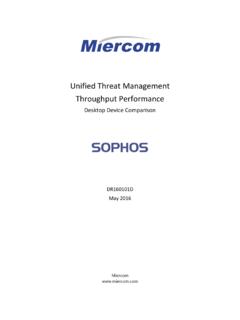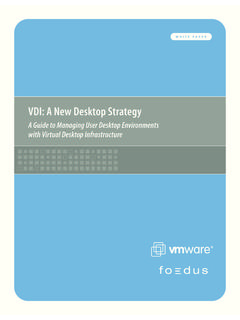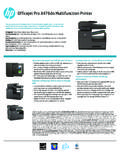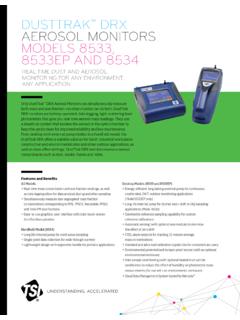Transcription of Application of Surge Protection Devices for Very Low ...
1 1 Application of Surge Protection Devices for Very Low Voltage Devices Mike Green Consulting Engineer- Lightning and over-voltage Protection Every year we are subject to more and more losses of equipment and down time due to over-voltage events. This increase in damage is due to both the increased usage of microprocessors in a greater range of products, and the continuing miniaturization of these microelectronic components. This paper offers a three point method for simplifying the Surge Protection Device (SPD) selection process, while pointing out the necessity for studying the Application in its entirety. The typical Very Low Voltage (VLV) device discussed in this paper is supplied with power in the form of voltage under 50V, and communicates via cable output of some sort. Typical examples range from the ubiquitous desktop PC or external modem, through industrial applications such as programmable logic controllers and on to video cameras mounted for security applications .
2 There are two avenues for over-voltage to enter our device and cause damage. One is through the power supply, typically a 230V AC feed transformed and rectified to anything from 3-48V DC. The other entry point for damaging over-voltage is through the communication lines; telephone, video, Ethernet- a plethora of configurations. There are two sources for destructive over-voltage. Atmospheric events such as lightning causes damage through both inputs, power supply and communication line. Switching events cause damage primarily to the power supply input, though it should be noted that switching high-current LV and MV events do create electromagnetic fields that induce voltage in the immediate area surrounding the switch, such that electrical switching can cause over-voltage damage to communication lines even though there is no galvanic connection what so ever between the power lines being switched and the communication lines passing near by.
3 Protecting our VLV device from the power supply input is a matter of complexity requiring an understanding of the grounding system used in the building, the parameters of the electrical distribution system, the potential short circuit at various points in the system, the relative immunity of the VLV device and the operating principles of the different proffered Protection Devices . However, it is relatively simple compared to the task of protecting our device from the communication input, which is the topic at hand in this discourse. For all the parameters necessary to correctly protect our device from the power supply input, some parameters are constant. The input voltage almost always originates from "wall voltage"; the standard AC low voltage distributed for residential and commercial purposes, 230V AC at the standard frequency of 50Hz.
4 Secondary voltages, should they be of interest in the defensive design scheme, may vary, but they are invariably of a single frequency-DC. The current passing through the conductor into the power supply input of our device is for the sole purpose of supplying energy to the system. Any change of current or voltage wave-form incurred by the nature of the chosen Surge Protection Device (SPD) is of little consequence. This is not the case when dealing with a conductor feeding the communication input of our VLV device. The voltage and current are carrying a signal. Clamping the peak to peak voltage, changing the frequency or other wise interfering with the signal is 2contrary to our ultimate goal- ensuring uninterrupted communication at all times, even during transient Surge events. Introducing an SPD on a communication input may save the device from damage, but it may also interfere with the stated purpose of the device- communication.
5 The methodology described in this paper simplifies the process of choosing the correct Surge Protection device by framing the Protection viewpoint with three questions: 1. From what are we protecting our device? What type of Surge is expected? 2. How much of the over-voltage must we clamp in order to protect our device? What is the inbred immunity of the device? 3. What type of communication are we dealing with? What are the characteristics of this communication protocol? These three questions will now be addressed in detail. 1. From What Are We Protecting Our Device? The primary cause of over-voltage events in the communication input of our VLV device is lightning. Understanding the physics and mechanics of a lighting discharge is of great value in designing a proper defense against this damage; however this is outside the stated scope of this paper- the Application of the SPD.
6 For the purpose of Application , we shall suffice with the definition of two types of lightning events, a direct hit into the superstructure containing our VLV device, and a lightning strike that is not a direct hit. Since we are dealing only with the communication input, switching over-voltages do not interest us in so far as they are defined as over-voltage between any two high current carrying conductors produced by making or breaking their circuit. Communication current circuits are not usually switched, nor do they carry high current. Any over-voltage induced by the electromagnetic field produced by opening or closing nearby circuit breakers in power distribution systems will be similar to atmospheric-induced over-voltages such as indirect lightning strikes. Direct Lightning Strike A lightning discharge into a superstructure, such as a building or antennae mast, can be quantified simplistically for the purposes of this paper as flowing to earth with an amplitude that can reach 100kA.
7 The rise time of the current is taken to be 10 s while the decay time to half the amplitude is considered to be 350 s. The energy dissipated during this stroke is estimated at MJ/ 1. This lightning current flowing to earth creates a voltage drop on the lightning path to earth directly relative to the impedance of the path, according to Ohms law UOV= Figure 1 demonstrates that if we assume the path to earth as being as good as 1 , we still have an over-voltage of 100kV between the incoming cable 1 DIN V ENV 61024-1 (VDE V 0185 Part 100) 3grounded at its point of origin, where the voltage of the ground is considered 0V, and the elevated point of the lightning strike. Figure 1: Over Voltage Due to Direct Lightning Strike The conclusion we reach from this analysis is that if a cable from outside the influence of our grounded structure is connected to our VLV device, and that a lightning strike can go to earth through our grounding system, then we must choose a device that can deal with a very high energy transient event.
8 Just how high the over-voltage and how much current will be directed to ground on the terminals of our device depends on how many conductors enter the structure, since the total voltage and current is divided equally between all incoming conductors. The amplitude of the over-voltage and resultant current are not as important to us as the wave form of the current, since the wave form carries the destructive energy- current over time. When dealing with a direct lightning strike that raises the potential of the communication input due to being referenced to ground outside the influence of our local ground, we look for SPD characteristics that can handle a 10/350 lightning impulse current. Indirect Lightning Strike Just as every current flowing through a conductor produces an electromagnetic field that induces voltage in any other nearby conductor, so too does the lightning stroke produce an electromagnetic field that induces voltage into any conductor in the vicinity.
9 A lightning strike of 100kA from cloud to cloud or to ground can induce as much as 2kV in every meter of conductor at a distance of 100 meters. Even at a kilometer, 200V can be induced in every meter of conductor2. 2 Source: Clark, O.; Gavender, R. : Lightning Protection for Microprocessor based Electronic Systems. Record of Conference Papers Industrial applications Society, 36th Annual Petroleum and Chemical Industry Conference 11-13 Sept. 1989, San Diego, CA, USA 4 The current created by the voltage induced by an indirect lightning strike is considered to have a rise time of 8 s with a decaying period of only 20 s to half the initial amplitude. This 8/20 wave form is what we will look for in current carrying capabilities of any SPD that is not expected to with stand the current due to a direct hit into a grounded installation.
10 Figure 2 displays the difference between direct and indirect lightning strikes vis a vis the current carrying capabilities of the SPD. It is evident that even though the amplitude of the two wave forms are the same, the amount of energy residing under the 10/350 waveform is many times more destructive than that under the 8/20 waveform. Figure 2: Comparison between Direct and Indirect Lightning Strikes Differentiating Between Direct and Indirect Lightning Strikes As a rule of thumb, if our building has any likelihood of being hit by lightning, due to it having a lightning down-system that will take the lightning to ground swiftly, and the cable connected to our VLV device originates (or terminates) from outside our building- we specify an SPD with 10/350 current capabilities. It is important to realize that down-systems that attract lightning are not always built intentionally.





